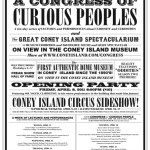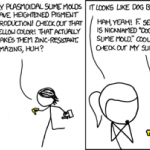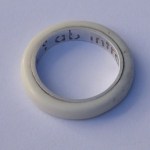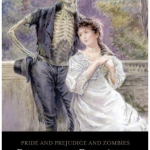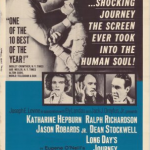
In addition to all the obvious reasons, tech blogger Jillian York recently noted that some web filters use comments, and links in comments, to categorize sites as pornography. This means even a blogger who diligently refrains from any, er, PhysioProfisms, can be classed as offensive and filtered based on comments alone. York explains how recently her blog was blocked by Websense:
My assumption was that their automated system was based on keywords, and that my blogging about Helmi Noman's paper ("Sex, Social Mores, and Keyword Filtering: Microsoft Bing in the 'Arabian Countries'") had caused…
And I do mean Dreadful.
In honor of Zombiefest, which is a totally random blogholiday I made up, and all my awesome readers, the first person to email me their US mailing address gets a copy of Pride and Prejudice and Zombies: Dreadfully Ever After. Wow - that took longer than I expected. :)
The 2011 Congress of Curious Peoples, featuring, among other guests, Anna Maerker, author of Model Experts: Wax Anatomies and Enlightenment in Florence and Vienna, 1775-1815; Mike Sappol, author of A Traffic of Dead Bodies: Anatomy and Embodied Social Identity in Nineteenth-Century America; Elizabeth Stephens, author of Anatomy as Spectacle: Public Exhibitions of the Body from 1700 to the Present; and John Troyer, author of Technologies of the Human Corpse (forthcoming). Whoa.
Learn more here!
I have a copy of "Alternative Careers in Science: Leaving the Ivory Tower" (1998 edition) that I'll mail to the first person who emails me their (US) address. Sorry, It's taken!
I can think of a few answers, but the Name Inspector points out that naming food is one: apparently the Corn Refiners Association is trying to rename "high fructose corn syrup" "corn sugar."
it's gotten an especially bad rap lately, partly because it has a name so long and scientific sounding that it has to be abbreviated.
First off, I don't think "high fructose corn syrup" is all that "scientific sounding"; try "monosodium glutamate" on for size and get back to me. It's also not that long: six syllables, people! But the interesting issue is that the aura of high-tech innovation and space-…
SOLAR from Ben Reubold on Vimeo.
Passed along by reader Miles, this visualization by Ben Reubold appears to depict a solar device patterned after a flower silently unfolding in space. I have no idea what the back story is, but it's very cool.
This is the biologist googly-eyed dazzled-with-biological-complexity effect that my friends and I used to describe as "because little fishes have eyes!" Be warned: once infected with the appreciation for biological beauty, there is no cure. :)
This is why I love xkcd. How is it possible I still run into people all the time who don't read it???
A really interesting post from Deborah Blum on the "radium girls" who painted wristwatches in the 1920s - to fatal effect:
At the factory, the dial painters were taught to shape their brushes to a fine point with their lips, producing the sharp tip needed to paint the tiny numbers and lines of watch dials, the lacy designs of fashionable clocks. Each worker was expected to paint 250 dials a day, five and a half days a week. They earned about $20 a week for that work, at a rate of one and a half cents per completed dial.
The painters were teen-aged girls and young women who became friendly…
Christopher Reiger has a great post at Hungry Hyaena about public communication strategies used by scientific advocacy groups, and where artists should adopt similar strategies:
Most Americans see science as extraneous esoterica crafted by white-coated wonks. Similarly, contemporary art is seen as the province of effete Onanists devoid of "family values." But the respective responses of the two realms to these ugly public perceptions is critically different. The scientific community has confronted the issue head-on, spilling ink, hosting panel discussions, and building programs. Whether or…
Reader Laura alerted me to a self-described "weird art & style blog" that many of you may enjoy - it's called Synesthesia Garden. A recent topic was custom lab-grown bone wedding rings (above):
Harriet Harriss, one of the participants, says: "I love the idea that it's precious only to us because it is, literally, us. It's almost worthless to anyone else. To take something that is from myself and make it into something precious is a lovely thing and means quite a lot to me."
She has also recently covered Nita Collins' scarred, grotesquely plaintive art dolls and Nicola Samori's faceless…
"You'd think that art is based more on intuition and science is based more on knowledge and fact, but what I think happens is that as you get more proficient in either of those fields, the intuitive knowledge base and the factual knowledge base become equally important. In this sense, Einstein may have been an artist because he used an intuitive sense of how things worked."
Yo-ichiro Hakomori, biochem BA & architect
wHY Architecture & Design
source
This week is zombiefest! Why? Because I finally had a chance to finish my reviews of two zombie-themed books. Up today is the third in the series spawned by the mash-up Pride and Prejudice and Zombies (P&P&Z), the new Pride and Prejudice and Zombies: Dreadfully Ever After.
The original P&P&Z was perfectly absurd - a slapdash collage of Austen with starkly anachronistic B-movie violence. As I noted in my review at the time,
At first I was unimpressed, thinking this has to be the laziest Austen rewrite ever! But the surprise is that the weird mash-up works, mainly because the…
The federal government, including NIH, isn't exactly seen as a hotbed of artsy drama types. ("Faceless gray mega-bureaucracy" might be a more typical descriptor.) So I was tickled to learn that the National Institute on Drug Abuse is framing a series of continuing medical education (CME) courses about addiction around dramatic readings of Eugene O'Neill's Long Day's Journey Into Night. And no, we're not talking about cheesy readers' theater - they got Debra Winger and several Tony nominated stage actors to participate.
As a threshold matter, this is cool because it shows that NIH recognizes…
Louis Vuitton, the high-end accessory company, is suing a Dutch artist, Nadia Plesner, for painting a likeness of one of their handbags in a work of art publicizing the conflict in Darfur. According to the artist's attorneys, the painting, "Darfurnica,"
is modeled after Picasso's Guernica and expresses the artist's surprise at the attention that is paid to nondescript celebrities like Paris Hilton, while humanitarian disasters like those in Darfur remain rather unnoticed. In the middle of the painting an African child is depicted, holding a bag. (source)
The artwork also includes portraits of…
. . . I know we are all thinking of the victims of last week's earthquake and tsunami, and of the ongoing nuclear plant crisis.
The Japanese Embassy directs would-be donors to the Red Cross, and asks that donors give to their local chapters. In the US, one can donate to the Red Cross here, or text REDCROSS to 90999 to make a $10 donation.
image: origami crane by kekremsi, from a design by Roman Diaz and Daniel Naranjo.
I guess it's not surprising, my dopamine is rising
And my glutamate receptors are all shot
I'd surely be bemoaning all the extra serotonin
But my judgement is impaired and my confidence is not
Allosteric modulation
No Long Term Potentiation
Hastens my inebriation
Give me a beer. . .
Physiology professors, I trust you know what to do with this holiday treasure by cadamole. Nothing makes neurobiology seem relevant like a beer.
For everyone frustrated with the unscientific, spotty, incoherent and often inaccurate coverage of the Japanese nuclear plant situation: one geo-blogger and her dad try to help out. Now THAT is how you use your scientific expertise to improve public understanding in a meaningful, immediate way. Bravo, georneys!

The Cyclotrope from tim Wheatley on Vimeo.
The cyclotrope is a cycle of 18 images that is spun at a certain speed so that the frame rate of the camera filming it gives the illusion of animation.
A humble suggestion to high school art/science/media teachers: if your curriculum is not already too constrained by standards and tests, there are near-infinite possibilities in a bicycle wheel, a camera, and art. . . think Muybridge.

When I was about eleven years old, I loved to draw intricate ornamental initials with sea serpents twining all over them and castles sprouting out of them, etc. Sometimes my friends would have me draw ink letter "tattoos" on them, but really, the only way I could get satisfactory resolution on my letters was to use a fine tip pen on a full sheet of paper. One letter = math class. (No wonder I don't know calculus).
That's why this new group show at San Francisco's Gallery Hijinks has me smiling with nostalgia - it's a full alphabet (plus) of letter-themed artworks. The organic,…
So lately I've been trying to understand open source licensing options for software code, which is hard, because I'm not a coder. (If I don't understand an xkcd, it's almost always because it's some sort of Python joke.)
Anyway, Michael Ogawa made some videos a few years back depicting the growth of various projects (Python, Apache) as various developers came on board and committed code to the pool. His Python video is fascinating; it starts in 1991 with Guido van Rossum, who slowly attracts other developers. Through 2000, you can easily watch individual participants come in and out of the…
